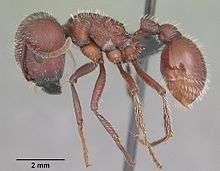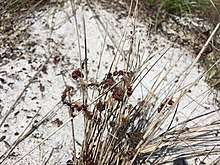Pogonomyrmex badius
Pogonomyrmex badius, or the Florida harvester ant, is a species of harvester ant in the genus Pogonomyrmex.[1] It is the only Pogonomyrmex species found on the east coast of the United States and the only one found in North America known to be polymorphic.[2][3] The species is ubiquitous in the Florida scrub habitats.
| Pogonomyrmex badius | |
|---|---|
 | |
| Pogonomyrmex badius worker | |
| Scientific classification | |
| Kingdom: | |
| Phylum: | |
| Class: | |
| Order: | |
| Family: | |
| Subfamily: | |
| Genus: | |
| Species: | P. badius |
| Binomial name | |
| Pogonomyrmex badius (Latreille, 1802) | |
Biology
Colonies can commonly be found nesting within well-drained sandy soils in xeric shrublands, grasslands, woodlands, and intact coastal dunes.[4] The nests of mature colonies are very deep; usually 2.5 to 3.0 meters deep with seeds being stored about 40-100 cm in large, flat granaries below ground.[5] On the surface, the relatively flat crater mound is decorated with detritus and charred plant matter, though the reason for this is unknown.
Labor partitioning in the colony is organized spatially in respect to the vertical axis of the nest as well as by age. The youngest workers, which care for the brood and queen, reside in the deepest portions of the nest while the oldest workers that actively forage and maintain the nest are found near the surface.[6] Among harvester ants P.badius is unusual for their frequent nest relocations, with colonies on average relocating once per year at a distance of 4-10 meters from the original nest site.[7] The benefits these relocations may have on colony fitness are unknown, but are seemingly an integral feature of the species' life history. Seed species favored includes Paspalum setaceum, Dicanthelium commutatum, Croton michauxii and others; though the seeds preferred are limited as workers cannot open seeds no wider than 1-1.4mm.[5] Aggression is notably less in comparison to other members of its genus, with workers seemingly reluctant to sting unless forced.
Workers are highly polymorphic, ranging from 6.35mm for the smallest workers to 9.52mm for the largest majors which can rival the queen in size. Workers are also most active in low relative humidity and high temperatures.[8]
Reproduction

Colonies become reproductively mature at a population size greater than 700 workers and begin producing winged individuals around spring. There is a strong investment in the production of male reproductives than that of females, with females being notably less populous than males and having more pronounced variation in size and weight. Nuptial flights were observed from May to June most frequently in days of calm, sunny and humid mornings between the hours of 9 AM - 2 PM following a day of heavy rain. Female and male alates can be found mating at leks or at the surface of their natal nest with hundreds of excited workers accompanying them. During the excitement workers begin to display aggressive behaviors towards alates that attempt to re-enter the nest, with alates being forcibly carried off from the nest entrance by workers.[9] [10]
Venom toxicity
Like most species belonging to the genus Pogonomyrmex, Badius is equipped with a stinger capable of delivering a highly potent and painful neurotoxic venom adapted for defense against predatory vertebrates. [11] The venom of this species is considerably toxic, with a mice LD50 of 0·42 μg/g - comparable to the most toxic snake venoms. [12] Though the yield per sting is significantly low, multiple stings may prove dangerous to otherwise healthy individuals. Along with a few other Pogonomyrmex species, Badius workers exhibit stinger autotomy in which the barbed stinger and venom sack is left embedded in the skin to continuously pump venom. The cost of this autotomy is the demise of the ant due to the internal damage from the stinger being pulled out, much like in Honey bees. [13]
References
- Bolton, B. (2015). "Pogonomyrmex badius". AntCat. Retrieved 30 January 2015.
- Cole, Arthur C (1968). Pogonomyrmex harvester ants. A study of the genus in North America. Knoxville, Tennessee: University of Tennessee Press. ASIN B0006BUR4W.
- "Florida harvester ant - Pogonomyrmex badius".
- https://www.antwiki.org/wiki/Pogonomyrmex_badius
- Tschinkel, Walter R.; Domínguez, Daniel J.; Pratt, Stephen C. (1 March 2017). "An illustrated guide to seeds found in nests of the Florida harvester ant, Pogonomyrmex badius". PLOS ONE. 12 (3): e0171419. doi:10.1371/journal.pone.0171419. PMC 5331987. PMID 28248988.
- Tschinkel, Walter R. (2 July 2004). "The nest architecture of the Florida harvester ant, Pogonomyrmex badius". Journal of Insect Science. 4: 21. doi:10.1093/jis/4.1.21. PMC 528881. PMID 15861237.
- Tschinkel, Walter R. (19 November 2014). "Nest Relocation and Excavation in the Florida Harvester Ant, Pogonomyrmex badius". PLOS ONE. 9 (11): e112981. doi:10.1371/journal.pone.0112981. PMC 4237378. PMID 25409332.
- http://entnemdept.ufl.edu/creatures/urban/ants/harvester_ant.htm
- Smith, C. R.; Tschinkel, W. R. (23 October 2006). "The sociometry and sociogenesis of reproduction in the Florida harvester ant, Pogonomyrmex badius". Journal of Insect Science. 6 (32): 1–11. doi:10.1673/2006_06_32.1. PMC 2990325. PMID 19537980.
- https://www.jstor.org/stable/3495654?seq=1
- "Pogonomyrmex sting & venom". www.davidlouisquinn.com. Retrieved 2020-06-28.
- Schmidt, Justin O.; Blum, Murray S. (1978-01-01). "Pharmacological and toxicological properties of harvester ant, Pogonomyrmex badius, venom". Toxicon. 16 (6): 645–651. doi:10.1016/0041-0101(78)90192-7. ISSN 0041-0101.
- Hermann, Henry R. (1971-06-01). "Sting autotomy, a defensive mechanism in certain social Hymenoptera". Insectes Sociaux. 18 (2): 111–120. doi:10.1007/BF02223116. ISSN 1420-9098.